At Home and in Paris
- Judith Mitrani
- Mar 5, 2023
- 21 min read
Updated: Jun 8, 2023
Life is full of surprises, not all of them bad
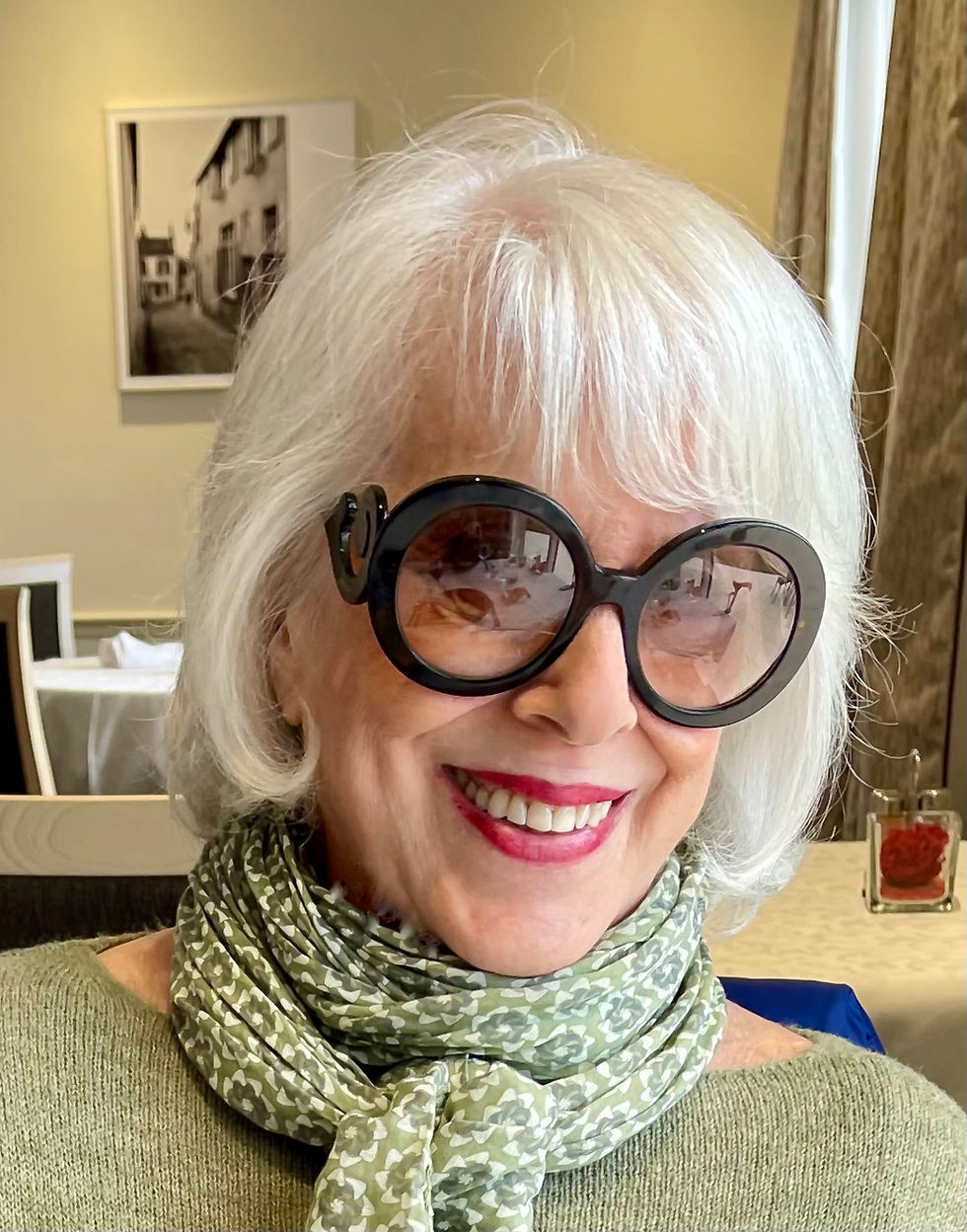
Yes, I've been remiss in writing to my loyal supporters recently. However, I was right in the midst of beginning to catch you up with my whereabouts during the month of January, on my way into the building of a dear old friend, Marie Claire, I stepped in through the porte-cochere in a very good mood and feeling comparatively fit that I walked into the lobby of the building whistling. Unfortunately , when I'm happy and skipping, I often forget that in Paris one must look down at all times to see where one is going. Thus, I neglected to take note of the large square of

marble that had accommodated a brush-like carpet on which one could clean their shoes from dirt, mud, or rainwater before stepping onto the marble flooring in the lobby. Suddenly the tip of my sport shoe was caught in the space between the carpet (which was all too worn out and should've been replaced many years ago) the exposed metal rim that surrounded the marble lobby floor. If you know me, you have probably already guessed that I flew some distance until I struck the floor on the right side of my chest, and reflexively turned just enough to prevent my head from hitting the marble as well, likely giving me a fractured skull. Unfortunately, this twist of my body, like a twist of fate, caused me to land my left knee (yes, the one without any cartilage) smack dab on that impenetrable flooring. I don't know which hurt worse, my chest or my knee, but I do recall hearing myself scream out in pain as I lie there helpless on the floor. Meanwhile, Marie-Claire's caretaker, Stella, had come downstairs wondering why we hadn't yet arrived. Although she and Ted wanted to help me up, I was convinced that the only way I could get back on my feet with any confidence would be with the aid of a very thick cushion under my knees. Stella took the lift up and back, delivering just what I needed before I could catch my breath. Once on my feet, I couldn't bear the idea that I just might need an ambulance to the nearest hospital. I convinced Ted that we could stay for lunch, blocking out some of the pain with a couple of glasses of good red wine and the

welcoming smiles and convivial conversation at the table. Of course, the first thing I did when I got home was to call and make an appointment for the next morning with my orthopedic surgeon, Dr. Deloin. However, there were more complications than expected. Since the last time I had been there, the clinic had been inundated with water during one of our bad storms and had been closed for repairs for a couple of months. In the meantime, Dr. Deloin was seeing patients at a sister clinic across town. Unfortunately, that clinic did not have a full radiology department, but instead used one belonging to a public hospital less than a kilometer away. 'Public' in France means that patients are not given appointments, but are seen on a first come first serve basis. Since it was urgent that I have x-rays of my knee and chest in hand to bring to my 10 am rendez-vous with Dr. Deloin, Ted came to my aid and was unusually demanding on the phone with the hospital and thus was able to secure me an 8:45 appointment for my x-rays. That seemed like enough time to be able to secure the radiographs for Dr. Deloin. However, I was once again thinking in terms of medical services back in the USA, where the x-rays would have immediately been electronically transmitted to my doctor, while I taxied back to his clinic. Of course, this was not at all the way it went down. They did take me in for my x-ray on time. However, I was told to wait for the radiologist to call me in. So I waited, and waited, and waited some more. Finally, I heard a young woman's voice calling me, only to find that she was requesting payment, after which she advised me to remain seated until the doctor called me. A short time later, the doctor appeared and informed me that I had a fractured patella, better known as a kneecap. He added that I was very lucky because it was a vertical fracture and not a horizontal one that would have required surgery to insert metal pins to hold everything together until the bone mended. As for my chest, he couldn't tell if any ribs were broken. He told me that if I wanted the report and the x-rays, I must return to the waiting room and that they would be out shortly. By now I was only 30 minutes late for my appointment with Dr. Deloin. But, by the time I received all of the necessary radiographs and the doctor's report, I had no chance of reaching Dr. Deloin until 11:15. He was very kind and emphasized how lucky I had been with my knee, which would heal in 2-3 months with thrice-weekly physical therapy, crutches, and a brace. But when we got to the chest x-ray, he noted quite a bit of fogginess that made it impossible to ascertain the extent of the damage. However, he could tell by my reports -- of extreme pain when I took a breath, coughed, sneezed, spoke, or anything else that might impact my rib cage -- that I had broken at least one rib that could take as much as six

months to mend and there was nothing I could do but lay low. He loaded me up with prescriptions for pain meds and a brace and I called home to Jeffrey to retrieve the wheelchair and crutches from the cave. Needless to say, when I went home, I was not in any shape, mentally or physically, to do much. It was even impossible for me to sit in a chair at my desk. Within a couple of days, as predicted, the pain in my chest had gotten much worse, and the kind doctor recommended that I make an appointment for a second thoracic radiograph. This second one was all too clear; I had three broken ribs, numbers six, seven, and eight. Six was the worst and the Doc said I was very lucky that there were no contusions or abrasions on my lung. Needless to say, I felt like I was in confinement once again, only this time I would be unable to sit up and write because of my knee and the medications I was taking left me sleepy and senseless. But life goes on, and the goodness of that life was never so clear as at my darling friend Caroline's

74th birthday party. She had always thrown herself a birthday party on 7 January and this one was the most festive I recall.
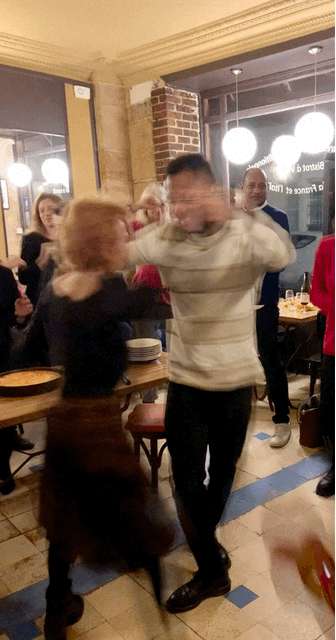
All broke out singing Stevie Wonder's "Happy Birthday" which started everyone dancing for two hours after a delicious Buffet dinner, prepared by the chef and the owner of this smal and charming restaurant, just big enough for the 30 or 40 friends of all ages, religins, nationalities, colors, and ethnicities. One of the most moving moments, after all the food and festivities, was when Caroline stood in the middle of the restaurant and read a beautiful memorial that she had written for her beloved husband Howard,
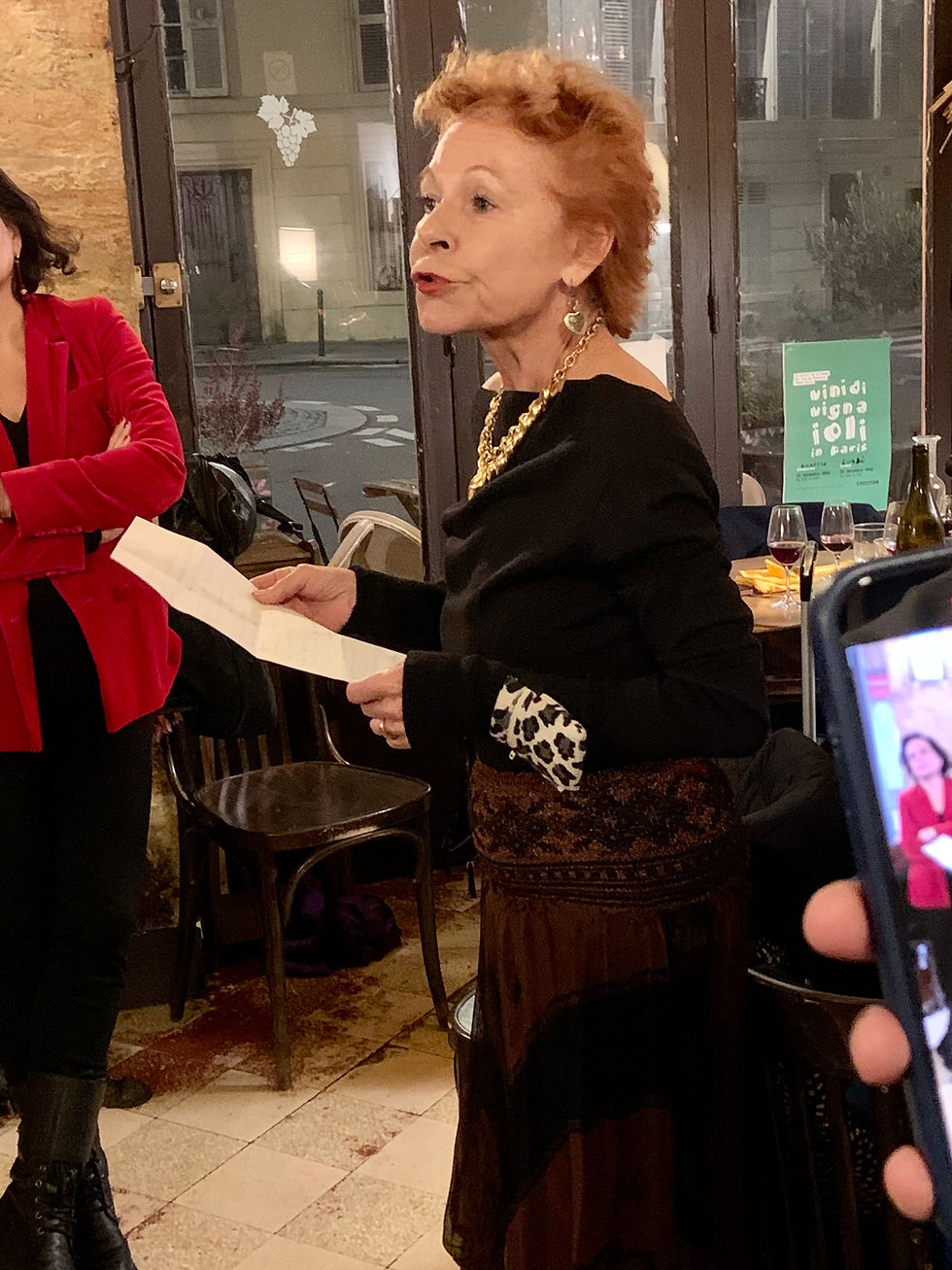
who had passed just a year ago. It was a moving experience for all present to hear Caroline's words filled with loving remembrances and sentiments shared by all, young and old, who knew Howard well. I was sad to

realize that this was the first year that Howard was absent for his wife's birthday and for this Valentine's day, too. I felt so fortunate this Valentine's day to have my husband. Ted took me out for a lovely evening at Restaurant Bel Canto, where the food is scrumptious and served by some of the best operatic voices accompanied by a marvelous piano, all of them waiters and waitresses (here we do not call them servers), and since that night, my spirits have been significantly lifted and I feel inclined once again to try to describe some of the more enjoyable happenings that occurred before my encounter with the marble floor in
MC's lobby.


As I promised at the end of my last post, I will attempt to catch you up on our adventures since our lovely trip to Beauvois at the beginning of the new year. First, Ted and I headed out for Auvers-Sur-Oise, the town where Vincent Van Gogh worked during the last years before his death. So many other Impressionists spent at least some part of their artistic lives in that spot outside of Paris during the 19th century including Paul Cézanne, Charles-François Daubigny, Camille Pissarro, Jean-Baptiste-Camille Corot, Norbert Goeneutte. We visited the spacious home of Daubigny which is now a museum where one can see paintings by the artist, his family, and friends such as Honoré Daumier, as well as rooms decorated in period style. Charles Sprague Pearce died there as well.

Along the river walk from Auvers to Pontoise we saw a number of views featured in the paintings of Pissarro. During the 20th century, artists continued to frequent Auvers, including Henri Rousseau, Otto Freundlich, and Pierre Daboval. The COBRA artist Corneille spent his last years in the village and is buried a few meters from Vincent van Gogh. COBRA was an international movement of pioneering artists who caused a revolution in modern art following World War II. It was the first truly international post-war avant-garde art movement, whose members sought new means of expression, based on spontaneity and experimentation for a new

society. Unfortunately, before we left home, we failed to check and found that the house of

Van Gogh was still closed for the winter season. Of course, we were disappointed, but we decided we would walk around the town and get a sense of what it would have been like to live here. On our next day trip, we headed for a small commune named Château-Landon which was the former capital of the Counts of Gâtinais, given to the King of France in 1068 by Foulques IV "le Réchin". It became a royal residence and Louis VI, Louis VII, and Philippe Auguste stayed there regularly. However, from
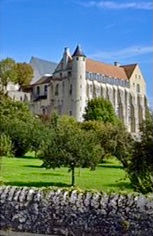
the 6th century onwards, the town became a major religious center and place of pilgrimage. Here is the story behind it: a monk named Séverin, who according to legend had miraculously healed Clovis (the first Christian Frankish king), came to die in Château-Landon around 511 AD. To honor the memory of this holy man, around 545 Childebert, son of Clovis, had the first basilica built. Over the centuries this was to become the great royal Abbey of Saint Séverin. Many of the faithful came to venerate the Saint's relics. Thanks to its powerful Abbey, which received gifts from the kings of France and many popes, Château-Landon became a very prominent religious center. In the Middle Ages, the town had 17 religious buildings including 4 monasteries and priories! At the end of the crusades, Foulques V, son of Count Foulques IV, le Réchin, and Count of Château-Landon became the first King of the Christian kingdom of Jerusalem. His son, Geoffroy, married Mathilda of England and became the head of the famous royal Plantagenet line, which was to reign over England from 1154 to 1485. This is this same Geoffroy who slipped a small branch of broom in his helmet, leading to the name "Plantagenêt" which was to make the family famous. We found a walking itinerary with ten medieval monuments and sights to discover throughout this small medieval town. A nice walk along the Fusain creek at the bottom of the rocky town ridge offered the charm of ancient washing facilities and views of the upper town monuments. We barely scratched the surface of what there was to visit in this interesting town and will surely return soon. But on that day, Ted had made us a reservation at what sounded like a very special restaurant for lunch in a village named Ferrières-en-Gâtinais.

We arrived right at our appointed time, yet we were greeted with odd looks by the maître d' and the waitress, who apparently were surprised that we had been given such a late reservation since this was their closing time. But they did seat us at a lovely table next to the window overlooking a grassy knoll and beyond we enjoyed the sight of the woods that surrounded the town. The restaurant was called Le Cheval Blanc, the White Horse, which adjoined a small hotel. From the amuse bouche

through another unexpected dish, our entrée and plat, and winding up with a marvelous dessert, all accompanied by a yummy bottle of burgundy wine, we were not only surprised by the chef's expertise, but the waitress was one who was genuinely interested in where we were from and how we came to visit this town. Her name was Stephanie. She told us all about the incredible features of this restaurant, which would definitely have a Michelin-star in Paris. In this small city, we could feast on a gourmet delight for only a fraction of the price. But alongside the delectable refreshments, although the town was quite small the restaurant was built by local carpenters who resided in the town, the threads for all the fabrics were manufactured locally, and the carpets,


draperies and all of the upholstery for the furniture were woven by residents of the town. The resident furniture makers created the chairs, tables and cabinets, and even the LED lighting throughout was manufactured in the town itself.
As we passed through the lobby on departure, we noticed a beautiful mural, about 4 x 10', that was created by the artist Marie Poirier who also lived in the town. It was a mosaic made up of individually handmade pieces of stained glass and replicated all of the major

buildings in the town, in front of which stood all of the famous people who had either lived or who had visited here. It was truly a marvel. We also asked about the beautiful, black-and-white photographs, framed and hung all over the walls of the restaurants, and found out that they too were created by a photographer that lived in the village. Each photograph depicted another aspect of the town and its surroundings. We had never heard a story quite like this before and were

simply flabbergasted. Our waitress also loaded us up with lots of brochures to make sure we wouldn't miss all that was special about her town. They described all the significant sites to be viewed in Pontoise and we knew at that moment that we would surely

return. But we did get to see the Abbey that appeared to be so very special, that we couldn't imagine leaving for home without visiting it in detail, even though we planned on returning for another lunch at this wonderful restaurant soon.





Two new dining experiences close to home here in Paris followed this day trip. First was a visit with Caroline who treated us to lunch at her favorite Creperie on her street, rue Montparnasse, which

has more creperies than the rest of Paris put together. The day was February 2nd, which is the day when France observes La Chandeleur, a.k.a. Candlemas, which is also. a day dedicated to eating crêpes. This Catholic religious holiday is exactly 40 days after Christmas, but it also has its origins in an older pre-Christian holiday celebrating the harvest and marking the midway point of winter. Caroline explained that her neighborhood was filled with so many creperies because the people who immigrated from Brittany by train disembarked at Gare Montparnasse nearby and opened creperies, both savory buckwheat and sweet wheat batter, because they liked this kind of food. Savory fillings might include ham, cheese, eggs, mushrooms, and other vegetables. Sweet crêpes (crêpes sucrées) are made from wheat flour. There is a range of fillings to choose from: chocolate

Nutella (hazelnut-chocolate spread), chestnut, and various fruit spreads, simple lemon crêpes with a filling of sugar and freshly squeezed lemon juice, and my favorite, crepes with Grand Marnier Liquor and sugar, or a flaming buttery orange liquor crepes Suzzettes. Traditionally crêpes are served with Breton cider, which is slightly alcoholic and fizzy. In some restaurants like this one, the cider is served in traditional small bowls.
Our next culinary adventure was a walk to one of the ten eldest, continuously operating authentic brasseries in Paris.A real delight to walk on a relatively balmy evening in the winter to a wonderful place to feast on an authentic old-fashioned French meal and then to be able to walk off the calories on the stroll home. This journey along the remnants of the Belle Epoque era is the Grand

Boulevards district, leading us to a square known for its fountain. On that square across from the fountain in front of a restaurant now owned by actor Gerard Depardieu is the Restaurant Drouant, the temple of French literature (home of the Goncourt and Renaudot prizes). One can also view the spectacular Ruhlmann staircase, the famous private dining room and dine in the warm atmosphere that made the establishment a success in the late 1920s. The gastronomic cuisine signed by the talented Chef Romain Van Thienen puts forward the classics of the House in a modern way!

The next day we caught the exhibition at the Maison Victor Hugo in The Place de Voges, one of the most storied locations in the Marais. This photo taken in winter does not do it justice, so I will include one from another warmer season.


The visiting exhibit was a retrospective of the work of Louis Boulanger (1806 – 1867) a French Romantic painter, pastellist, lithographer, and poet, known for his religious and allegorical

subjects, portraits, genre scenes, costumes drawn for the opera, and illustrations for Hugo's works as well as works written by other literary masters, such as Cervantes Don Quixote and beloved characters from Les Miz.

A Portrait of Hugo and his son hung on a wall in the salon on the second floor. which had been his apartment and the study where he wrote. Along with a large collection of art by famous painters and sculptors were a bust of Hugo and one of his wife as well.



After our visit to Hugo's home, we strolled around the edges of the Pace de Voges, admiring various contemporary works of art, clothing, and crafts, and we stopped for lunch at one of the many bistros sprinkled around the Place.



Our next truly special affair was the 80th birthday party that was arranged at a very historic spot for our friend, Alain Gibeault by his two sons, Mathieu and David. Alain and his wife Monique were both colleagues of ours and are the oldest friends we have in Paris, having met in Los Angeles in 1987.


Their two sons had grown up since we last saw them so many years ago, and Mathieu's little boy is a handsome little man, just like his grandfather and his father and mother. The party was a joyous event indeed, with all the guests mixing it up, and a very talented singer at both the piano and on the guitar all evening long .


Both Ted and I met some lovely friends of our friends, and another couple, Claudine and Richard, whom we had known almost as long as the birthday boy, were a welcome sight.


Ted and I both spent a lot of time taking photographs as souvenirs for our friend when we noticed that no one else was doing so. After all, it's not every year you turn 80 and celebrate at such a prestigious place! So I will indulge in a bit of history, and include a few pictures.The Auberge du Port du

Salut, built in the 18th century, replaced an older establishment that the poet François Villon had already visited in the 15th century. It seems that at the beginning of the 20th century the place was called “Au Port-Salut”.

Françoise Rosier, René Cozzano and Jacques Massebeuf opened the cabaret in 1955, which they called “Le Port du Salut” and which became one of the most famous cabarets on the left bank.

Between 1955 and 1982, many artists made their debut there and became famous: Bernard Lavalette, Richard Marsan (1955), Guy Béart, Barbara, Guy Bedos, Pierre Doris (1956), Georges Moustaki, René-Louis Lafforgue (1957), Jean Yanne, Anne Sylvestre (1959), Serge Gainsbourg, Jean Ferrat(1960), Romain Bouteille (1961), Pierre Perret, The Enemy Brothers (André Gaillard and Teddy Vrignault (1962), Boby Lapointe (1963), Morice Benin (1965), Jacques Debronckart, Maurice Fanon, Pia Colombo, Dadzu, Jean Hébrard, Bernard Dimey, Jacques Mailhot, Dominique Grange (1967), Pierre Doris, Daniel Guichard, Jacques Yvart, Les Enfants terribles (1968), Jean Harold,

Yvan Labéjof, Coluche (1972), Éric Vincent author of the song Le Port du Salut, Paul Préboist, Pierre and Marc Jolivet (1973), François Corbier, Josee Moonens, Serge Llado, Pierre Péchin, Ricet Barrier, Patrick Sébastien (1975 ), René-Louis Baron (1980).


Maurice Mignot plays the role of pianist of the Port du Salut during all these years Many others have performed there: Bernard Montangero, Florence Camaroque, Cocagne and Delaunay, Jacques Delord, Otto Wessely, Michel Dejeneffe, Bernard André,

David and Dominique (David Jisse and Dominique Marge ), John Guez, etc. Jean-Pierre Maury, actor-poet ( Le Funambule poétique, Les Chandelles ), who had his molding workshop on the first floor of the cabaret since its opening, came to join the co-direction with Françoise Rosier following the departure of Jacques Massebeuf. The cabaret closed its doors in 1982 and the Port du Salut became a simple restaurant until, in 2010, Gérard Chambre, accompanied by his musicians ( Yorfela and Mika Apamian) revived the cellar! At present, the main floor of the restaurant can be rented out for private parties with plenty of good eats and wonderful music, as well as the atmosphere with all of the historic photographs of all of the famous people who had performed and dined at this Parisian institution. As for birthday gifts, each of Alain's friends contributed to a wonderful cruise down the Nile in Egypt for both Alain and Monique to enjoy together‼️

Closer to home, we walked to The Church of the Madeleine on the last day of a very special exhibit called the tears of joy. Since they had been renovating both inside and outside with an eye toward the Summers Olympics in 2024, we had not been inside since Christmas last year, we decided to make it there for the last day of the exhibit and see what else has changed.

We were amazed to see how much they had polished up the inside of the church and this fantastic display of 1000 handblown tears, each one filled with something special.

Our famous organ had been polished up!



This next bit may increase my reputation for being mad about Catholic churches, but I must confess that the day after our visit to The Madeleine, we went to get our haircuts, and it just so happens that our Coiffeur Eric recently moved his salon to the passage behind a beautiful old church, Saint-Philippe du Roule. in the 8th Arr. Eric is always right on time and we have gotten the message that he is perturbed by people who arrive too early, taking his attention away from the client he is with before our time. Because I hate to keep him waiting, we are frequently too early, so we walk into the church through the back entrance doors just across from his salon and use the time for meditation or jusenjoy the architecture.

On this visit, we discovered a hefty booklet, listing and describing all of the Catholic churches in Paris. It was at that moment that we realized that we had just begun to enjoy the beauty both outside and inside of all of these religious buildings.


The Église Saint-Philippe-du-Roule is a Roman Catholic church located at 154 Rue du Faubourg-Saint-Honoré in the 8th arrondissement of Paris.Resembling a Roman temple, it was built in the style of Neoclassicism between 1774 and 1784 by architect Jean-François Chalgrin best known for his design of the Arc de Triomphe. It was enlarged in 1845 by the architects Étienne-Hippolyte Goddeand Victor Baltard. The following day, we decided to have lunch at a lovely restaurant we had once dined in many years ago in the town of Neuilly-sur-Seine. We also wanted to visit the stunning church we had seen across the park at that time.

Le Winston was a charming place to enjoy a well-prepared meal. In spite of its name, the food was not English but quite French and the clientele was very different from the clientele you would see in Paris just a kilometer away. Mostly women of a certain age and some groups of couples, all very well dressed and mannerly, all drinking wine and most taking their time to enjoy and not just a good meal, but a friendly repartee. The Church was The Eglise Saint-Pierre and it was well worth the visit. The exterior was quite impressive even from a distance but the interior had many surprises.

Built in the late 1800's, this Romanesque-style church is quite impressive. The details and the workmanship always astound me. A mix of mosaic & wooden flooring, and beautifully carved confessionals, amongst other pieces, this church boasts stunning stained glass windows. It is a respectable size but still awe-inducing. It is well kept

and maintained, still used by those of the faith, and very much worth a visit. We took a few photos that I will share here, but there was so much more to see and enjoy in this unusually bright and cheerful environment.



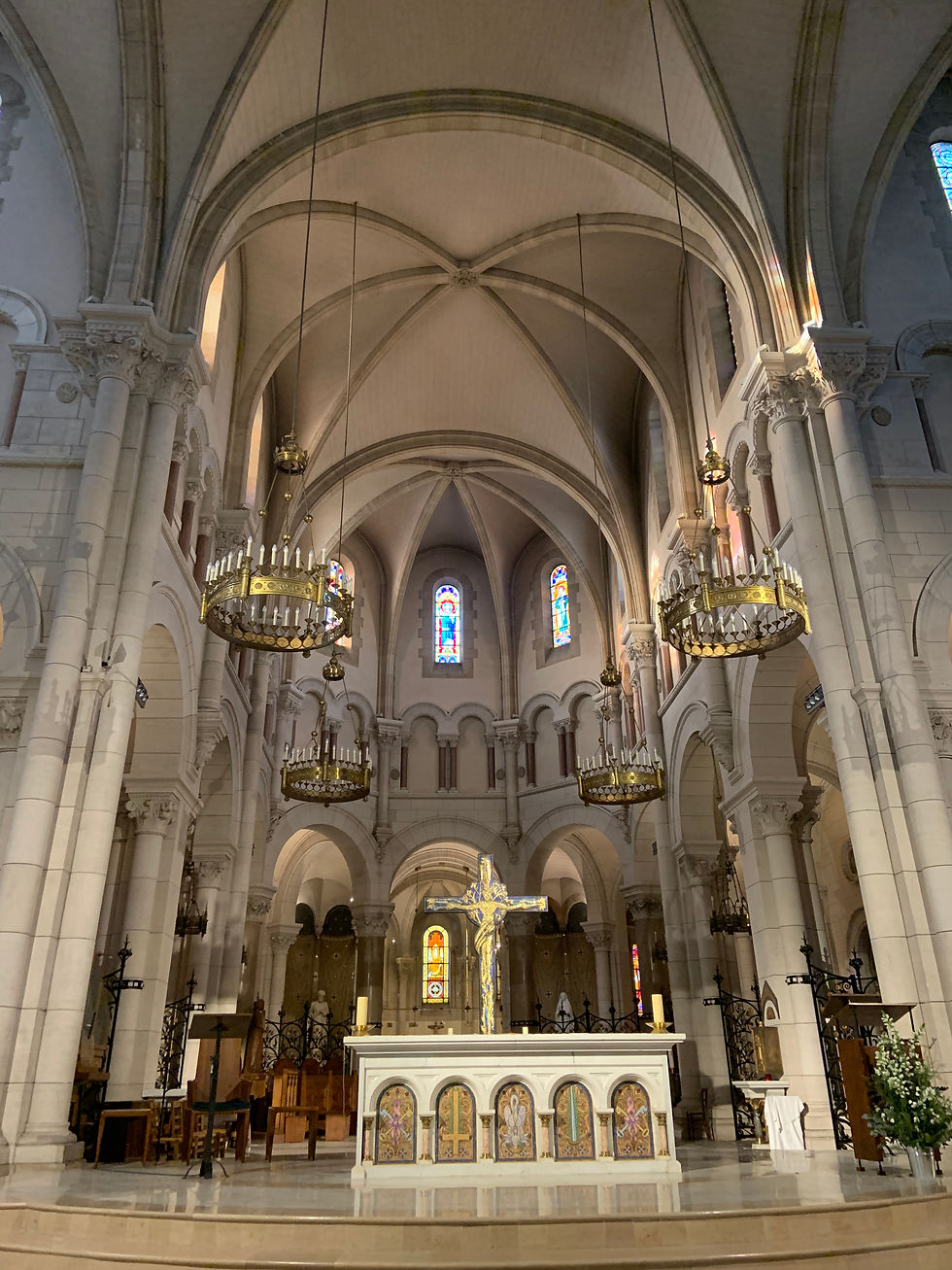
Sunday, the day after this spiritual visit, we decided to pay tribute to something we had not seen except from afar for many many years; Actually, it had been 15 years since our 25th wedding anniversary, when we had dinner at the luxurious Jules Verne restaurant high up in the Tour Eiffel.

We had just read an article about a new Brasserie built right under the Jules Verne in the tower. The name of the Brasserie is quite

inviting: Madame Brasserie! They promised to be gorgeous and so we thought we would take advantage of once more riding up the elevator and having a leisurely luncheon in the most famous landmark in Pari. Guy de Maupassant was said to have hated the Tour Eiffel so much that he ate lunch there every day because it was the one place in Paris where the tower was not visible! I laughed when I heard this for the first time, but totally disagreed with it. Every time the Eiffel Tower comes into sight, whether I'm walking or driving, from near or far, my heart jumps out of my breast and I am so excited to be at home and in Paris. For those who can't afford to go to the Jules Verne restauant for lunch or dinner,

Madame Brasserie is a wonderful alternative on a clear day or night. The staff is welcoming and you are immediately served a flute of champagne, your choice of entrée and main course, with red or white wine, and your choice of dessert, and coffee or tea. I must say that the food is quite passable but the dark chocolate Mouse is probably the best I've ever had in France and it's topped by three moist and scrumptious brownies. The only thing that was missing was the creme Chantilly! For visitors that are on a strict budget, it is a

little bit pricey but well worth it since you can spend the entire afternoon or evening enjoying this gorgeous view. I must say that, as disheartened as I was that weekend because of the return of my topical dermatitis, and my four broken bones limiting my walks outdoors when we have been having such beautiful weather, depriving me of skipping and jumping through this fabulous life the way I like to do, this spontaneous visit cheered me up no end. Sharing the views on this day with the man I adore, a day with the bluest of blue skies speckled with my favorite Magritte clouds and now sharing this experience with all of you gives me back my state of joy that I thought would be lost for the rest of my days.



I was not only cheered up but I was granted a lovely forgot forgetfulness of what it happened to us after we passed through the second security point and arrived at our table. I went to take my handbag off of my neck so that I could remove my coat, and all of a sudden I realized that I had left it behind on the conveyor belt. I was panic-stricken, to say the least. Everything of importance was left in that handbag including my 10-year resident card and my coveted driver's license, both of which I had worked my patout off to obtain. Never mind the credit cards and the cash and my blessed Carte Vitale that gave me the best health insurance I have ever known. The waitress saw my distress and promised that my handbag would be found, and reassured me that this happens with women all the time, and their handbags are always found. The director of security and the manager of the restaurant both accompanied Ted to search for my sac, and returned smiling in 10 minutes with the prize in hand!

As we were driving home from this blissful afternoon, we passed through the Place de Concorde, as we usually do, and were dismayed to see that both our beautiful nautical fountains had been covered with scaffolding. However, it will have been worthwhile when the scaffolding comes down to reveal these art-filled fountains, gloriously restored to their original beauty; Something we had never seen before in our over forty years here in Paris.
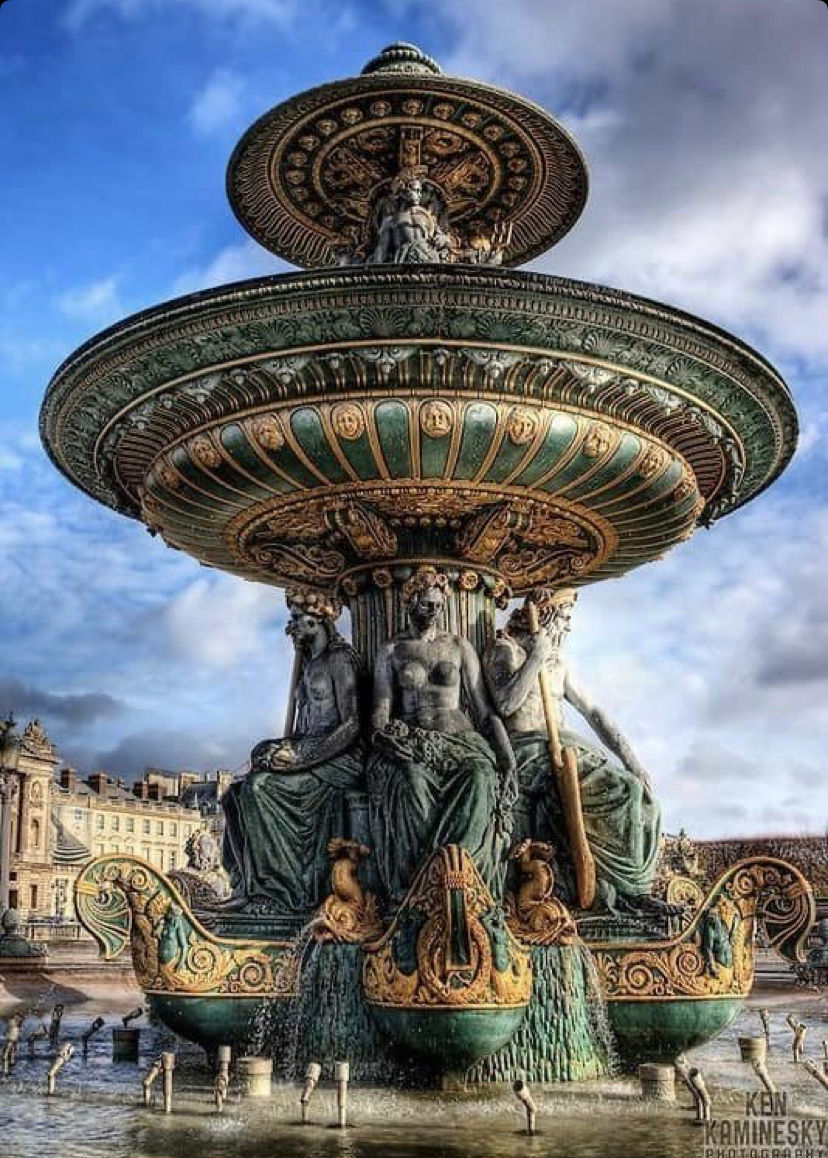
Our last day-trip was this past Tuesday when we took the two-hour journey to a small city named Soissons, a commune in the northern French department of Aisne, in the region of Hauts-de-France. Located on the river Aisne, about 100 kilometers (62 mi) northeast of Paris, it is one of the most ancient towns in France and was probably the ancient capital of the Suessiones. Soissons is also the see of an ancient Roman Catholic diocese, whose establishment dates from about 300 AD, and was the location of a number of church synods called "Council of Soissons". Soissons is historically famous for having been the first capital of The Franks (France). Its importance came from its location on the river Aisne, a natural junction point between the regions of Picardy, Champagne, and Ile de France. The City Hall as pictured below. Soisson's gorgeous cathedral has been undergoing extensive renovations. Most impressive is the great Rose window that is being restored bit by bit after it was destroyed in a terrible windstorm years ago.








But the most impressive structure in Soissons, the one that we visited after a splendid lunch at The Restaurant Grenadin, was as the remains of The Abbey of Saint-Médard de Soissons




a Benedictine monastery, at one time held to be the greatest in France.The Abbey was founded in 557AD by Clotaire I on his manor of Crouy, near the villa of Syagrius, just outside the then boundaries of Soissons to house the remains of Saint Medardin a golden box, the legend being that during the funeral procession, the bier came to a standstill at Crouy and was impossible to move until the king had made a gift of the whole estate for the foundation of the Abbey.

Besides Saint Medard, Kings Clotaire I and Sigebert I were also buried here. In 751 Childeric III was deposed here, and Pippin the Short was crowned. Richard Gerberding, the modern editor of

Liber Historiae Francorum places its anonymous author here, ca 727. Hilduin, Abbot from 822 to 830, obtained in 826 from Pope Eugene II the relics of Saint Sebastian and Saint Gregory the Great, and also succeeded in obtaining the transfer to the Abbey of the relics of Saint Gildard and Saint Remigius. He rebuilt the church, which was consecrated on 27 August 841, in the presence of Charles the Bald and seventy-two prelates; the king himself assisted in carrying the body of Saint Medard into the new church. In 804, Pope Leo III stayed at Saint-Médard, having celebrated Christmas with Charlemagne at Quierzy.In 833AD Louis the Pious was imprisoned and underwent public penance here. In 1121, after a council at Soissons where he was accused of heresy, Peter Abelard was, as punishment, confined to the convent of Saint Medard. In 1131 Pope Innocent II reconsecrated the rebuilt church and granted those visiting it indulgences known as "Saint Medard's pardons".
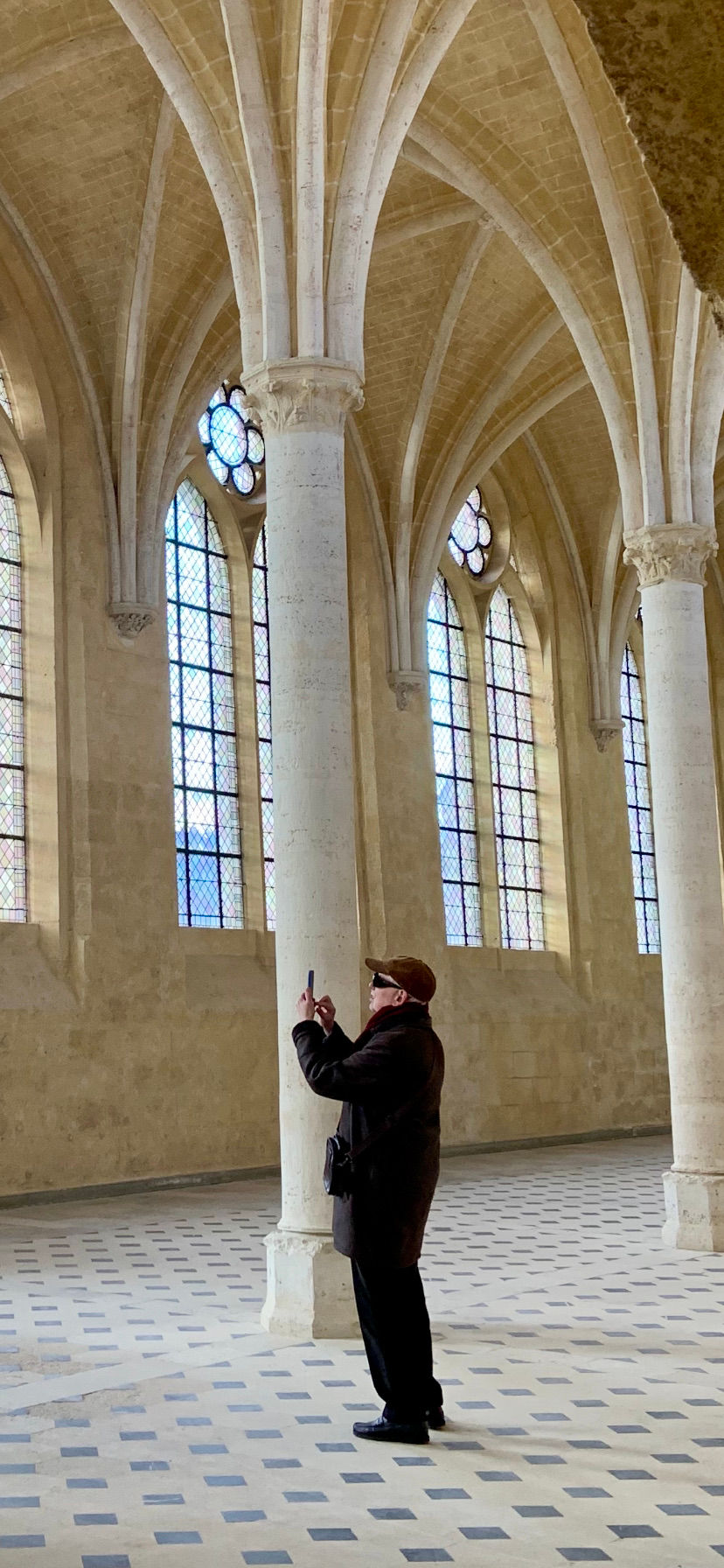

The wealth of the abbey was immense. In the 12th century the community-owned about two hundred and twenty fiefs. The abbey also minted coins. Its wealth remained into the 16th century but the abbey was destroyed in

1567 during the Wars of Religion, and although it was restored in 1637, it never regained its former stature. The abbey was dissolved in the French Revolution. The buildings had disappeared by the beginning of the 20th century, except for the still extant but almost forgotten crypt of about 854 AD.
We found it astonishing that directly across the large square from these stupendous ruins stood a newly built Academy for music and the arts below.

On the road again towards Paris, we enjoyed the bright green and beautiful countryside and newly planted agricultural fields, and yet we could hardly wait to get back to our Mickey! I'm hoping this story was worth the wait and the read, and that you will share your comments with me and the link with your friends. A Biento!




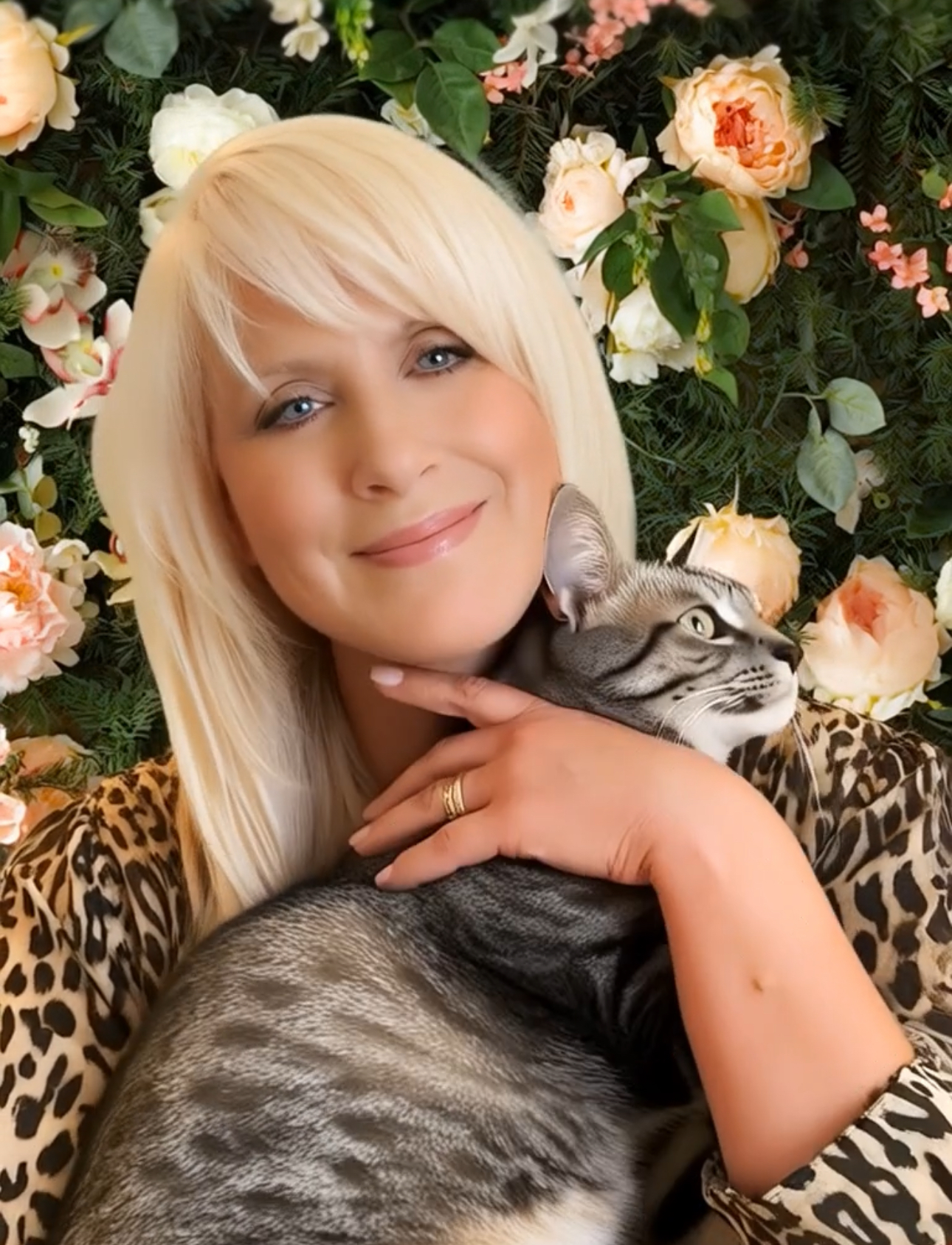


Comments